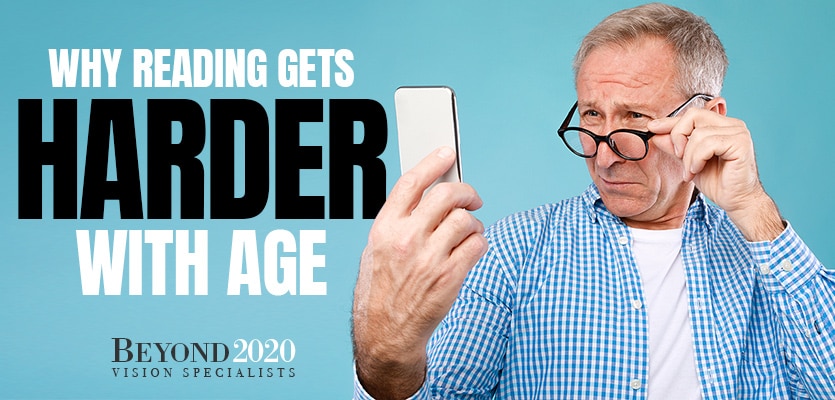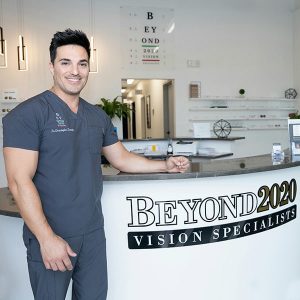Why Reading Gets Harder with Age
Home » Why Reading Gets Harder with Age

Why Reading Gets Harder with Age
Muscles tend to become less flexible with age, and almost everyone seems to accept it. The same effect happens to eye muscles too. However, because muscles in the eye affect vision, the changes seem to cause more concern. As age increases, the lens adds new layers every year. Even more, the layers become stiffer. Understandably, thicker and stiffer lenses make it harder to flex and change shape to focus on something close by.
Learning What Happens
The lens in the eye has softness and flexibility in young people, and tiny muscles can reshape it to let them focus up close when they read. Unfortunately, time weakens muscle control over pupil size.
You may notice that your pupil seems smaller, and you know for sure that it responds less to light. The smaller pupil size makes it harder to see anything in low light or at night. While an inconvenience and may seem unfair, the condition can make a 60-year-old need three times the light that young people require.
Reading Fine Print
Aging brings vision issues, and one that occurs for almost everyone presents problems in reading the fine print. It becomes more difficult as the lens changes with time. While reading the fine print has some comedic references, it has a specific meaning for older Americans. Unfortunately, the lens starts to show the effects of aging as one of the first parts of your body to do so. The difference becomes distinct between age groups.
The location of the lens right behind your iris and pupil lets it help focus light and form images on your retina. Before flexibility starts to diminish, it lets you see up close or far away without even thinking about it. The changes that age creates can start as early as the 20s. However, it may take decades to notice the gradual effect.
Experiencing a Prevalent Condition
Almost everyone eventually copes with age-related lens stiffening. The problem of focusing on something up close comes with presbyopia. Some people try to remedy the issue by holding things at arm’s length. A researcher at the National Eye Institute recommends the simple alternative of reading glasses. A basic eye exam at Beyond 2020 Vision Specialists can confirm the condition. Optometrist Dr. Christopher Tumolo can treat it with glasses or contacts.
Treating Loss of Flexibility
Unfortunately, no treatment can restore youthful flexibility to your eyes as you age. However, routine eye exams with correction options help keep your vision performing at its best. In addition, a nutritious diet and exercise guard against age-related vision loss. Glasses with a reading component help reduce eye strain that may come from blurry reading. A prescription for reading glasses or contacts needs an update every year or two to respond to continuing vision changes.
Responding to Another Age-related Vision Loss
Cataracts come with age also, and they can take a long time to develop. Creating a cloudy area in the lens, and making everything appear as though behind a fog. Not only does fine print present problems with vision, but cataracts make it hard to drive at night. In addition, they may make you not recognize a familiar face. Even worse, the lack of clarity may make you misjudge a step.
People usually get cataracts along with other age-related changes. By age 40, the proteins in the lens may start breaking down into clumps that cloud the eye. Surgical removal offers the only treatment, a highly successful procedure. Experts estimate that more than 24 million Americans over age 40 have cataracts. A prediction for about half of the population to have them by age 75 shows it’s likely to happen to anyone.
In cataracts’ early stages, you may rely on glasses and stronger lighting to help you see. However, symptoms become more bothersome as they mature. Sensitivity to light and glare makes shopping in well-lit stores unpleasant, and halos around headlights pose a danger in driving. Eventually, cataracts interfere with vision.
Realizing the Importance of Regular Eye Exams
The slow development of vision problems in seniors can prevent regular eye exams. However, early detection can provide treatment that improves vision. Every age group needs regular eye exams, and the frequency increases with age. Before age 40, a visit to an optometrist every three years works well for generally healthy adults.
After age 40, people need it every two years. An exam for seniors over age 55 needs to happen every year or two. Visits may increase for anyone who wears glasses or contacts. Further, anyone who has macular degeneration, glaucoma, cataracts, or diabetes needs more frequent exams. A family history of vision loss points to the need for regular exams.
Scheduling an Appointment
Odessa and the nearby communities of Trinity and Cheval have convenient access to an Odessa eye doctor. A location in the Crossings Shopping Center at 16230 Highway 54 next to the Sunshine Expressway requires only a short drive. At Beyond 2020 Vision Specialists, Dr. Christopher Tumolo offers new and existing patients professional care with a personal touch. Anyone who needs an eye exam may schedule one online or call 813-926-5993 to bring eye care up to date.

